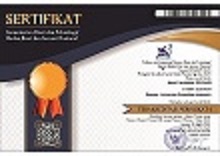PENERAPAN KONSEP REGIONALISME PADA PERANCANGAN CITY HOTEL BINTANG EMPAT DI KOTA PATI
Abstract
Full Text:
PDFReferences
Bambang Budiarto. (2019). Hotel Bintang 4.
Dharma, A. (2014). Aplikasi Regionalisme Dalam Desain Arsitektur. Fakultas Teknik Sipil Dan Perencanaan, 1–5.
Farel, R. R., Suroto, W., & Hardiana, W. (2014). Aplikasi Arsitektur Regionalisme pada Perancangan Holet Resort di Kawasan Wisata Mandeh, Sumatera Barat. Arsitektura, 15(2), 439–446.
Ghassani, A. I., Permana, A. Y., & Susanti, I. (2019). Konsep Ekowisata Dalam Perancangan Resort di Kabupaten Ciamis. Jurnal Arsitektur TERRACOTTA, I(1), 11–21.
Hamidi. (2005). metode penelitian kualitatif. UMM press.
Kartono, J. L. (2005). Konsep Ruang Tradisional Jawa dalam Konteks Budaya. Dimensi Interior, 3(2), 124–136.
Kemenparekraf, I. (2013). Peraturan Menteri Pariwisata and Ekonomi Kreatif No. 53 tahun 2013. Peraturan Menteri Pariwisata Dan Ekonomi Kreatif Republik Indonesia, 227.
Keputusan Mentri Pariwisata, P. dan T. N. K. 94/HK. 103/MPP.-87. (2016). Keputusan Mentri Pariwisata, Pos dan Terekomunikasi Nomor KM 94/HK.103/MPPT-87. In Keputusan Mentri Pariwisata, Pos dan Telekomunikasi Nomor : KM. 94/HK.103/MPPT - 87 Tentang Ketentuan Usaha dan Penggolongan Hotel Menteri Pariwisata, Pos dan Telekomunikasi, Menimbang Mengingat a . bahwa unt uk mendorong pertumbuhan dan pengembangan Par (Issue April).
Muflihah, A. N., Ayu, D., & Natalia, R. (2020). KAWASAN WISATA WATERFRONT TANJUNG ADIKARTO. Jurnal Arsitektur ZONASI, 3(1), 76–88. https://doi.org/doi.org/10.17509/jaz.v3i1.17892
Paramita, T., Saladin, A., & Rahma, N. (2021). PEMANFAATAN PENCAHAYAAN ALAMI IKLIM TROPIS PADA BANGUNAN HOTEL RESORT DI BALI. Jurnal Arsitektur Zonasi, 4(1), 114–120. https://doi.org/doi.org/10.17509/jaz.v4i1.27141
Permana, C. S., Permana, A. Y., & Dewi, N. I. K. (2020). Penerapan Konsep Green Architecture dalam Perancangan Hotel Resort di Kabupaten Tasikmalaya. UNDAGI: Jurnal Ilmiah Arsitektur Universitas Warmadewa, 8(2), 82–94.
Setyowati, M. D., Arsitektur, P. S., Sains, F., & Yogyakarta, U. T. (2011). Pemanfaatan Pedestrian Ways di Koridor Komersial di Koridor Jalan Pemuda Kota Magelang. 15(1), 13–22.
Tisnawati, E., Ayu Rani Natalia, D., Ratriningsih, D., Randhiko Putro, A., Wirasmoyo, W., P. Brotoatmodjo, H., & Asyifa’, A. (2019). Strategi Pengembangan Eko-Wisata Berbasis Masyarakat Di Kampung Wisata Rejowinangun. INERSIA: LNformasi Dan Ekspose Hasil Riset Teknik SIpil Dan Arsitektur, 15(1), 1–11. https://doi.org/10.21831/inersia.v15i1.24859
Walter A., R. & R. H. P. (1985). Hotel and Planning Design. Architectural Press Ltd.
Yudhanta, W. C. (2018). PENGARUH KONFIGURASI DAN VISIBILITAS RUANG PADA AKSESIBILITAS, Studi Kasus pada Kawasan XT Square Yogyakarta. Jurnal Arsitektur KOMPOSISI, 12(1), 67. https://doi.org/10.24002/jars.v12i1.1647
DOI: https://doi.org/10.17509/jaz.v5i1.41525
Refbacks
- There are currently no refbacks.
Copyright (c) 2022 Faisal - Darmawan

This work is licensed under a Creative Commons Attribution-ShareAlike 4.0 International License.





